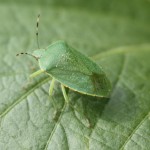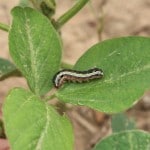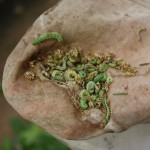 Stink Bugs. Very few fields are at R2 and R3 at this time, but stink bugs are concentrated is some of these early fields. We’ve been doing scout schools this week, and most of what I’ve been seeing is adult green stink bugs. This is the most common species in Tennessee. Normally, stink bug populations start building in earnest until R4 and R5. However, they sometimes concentrate in a few fields that are ultra early compared with the remainder of the crop. Treat anytime between R1-R7 when stink bug numbers average 36 or more per 100 sweeps.
Stink Bugs. Very few fields are at R2 and R3 at this time, but stink bugs are concentrated is some of these early fields. We’ve been doing scout schools this week, and most of what I’ve been seeing is adult green stink bugs. This is the most common species in Tennessee. Normally, stink bug populations start building in earnest until R4 and R5. However, they sometimes concentrate in a few fields that are ultra early compared with the remainder of the crop. Treat anytime between R1-R7 when stink bug numbers average 36 or more per 100 sweeps.
 Yellowstriped armyworms have required treatment in late planted soybeans in some areas, and like last year, the action is mostly in the counties bordering the Mississippi River. It is very unusual to have to treat for this insect, but this is two years in a row where we’ve had problem fields. Don’t get too excited about seeing some yellowstriped armyworms. They commonly occur in low numbers, but treatment should be made prior to bloom if defoliation exceeds 30-35% defoliation. This may seem high, but soybean can tolerate a lot of leaf feeding prior to bloom. Reports indicate that the synthetic pyrethroids are providing good control.
Yellowstriped armyworms have required treatment in late planted soybeans in some areas, and like last year, the action is mostly in the counties bordering the Mississippi River. It is very unusual to have to treat for this insect, but this is two years in a row where we’ve had problem fields. Don’t get too excited about seeing some yellowstriped armyworms. They commonly occur in low numbers, but treatment should be made prior to bloom if defoliation exceeds 30-35% defoliation. This may seem high, but soybean can tolerate a lot of leaf feeding prior to bloom. Reports indicate that the synthetic pyrethroids are providing good control.

Corn Earworm. It may be a little early because corn earworm has typically been a problem for us a few weeks down the road. However, reports to our south indicate serious infestations are showing up. Corn earworms (a.k.a. bollworms) feed on pods. Infestations usually start at full bloom (R2), but they can start earlier and may continue as long as flowers are present. This is not usually a common problem but high infestations can be devastating if left uncontrolled. The treatment threshold is 36 larvae per 100 sweeps. The standard treatment is synthetic pyrethroids, but there are other good options out there including Belt, Steward and Tracer.


Are you doing blogs instead of an email newsletter this year? Is there any way I can subscribe to receive the blogs by email?
That is correct. The blog has replaced the old newsletter format. However, I do send out an email notification with links to articles. I added your address to this distribution list. Thanks for your interest.
Please add me to your notification lists for cotton and soybeans. Thanks!
Will do